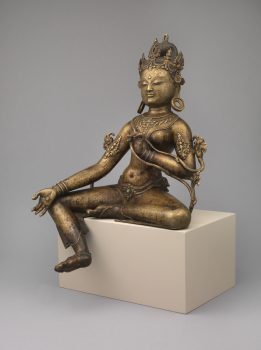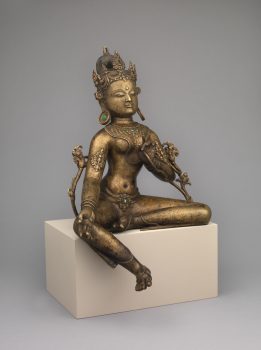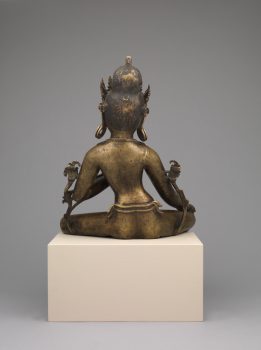Tibet
13th century
The right hand is extended in a giving gesture.
Tibet
13th century




One of the most beloved deities in Himalayan and Inner Asian Buddhist traditions, Tara, known as the “saviouress,” is often appealed to through the recitation of her invocation (mantra), known to lay and religious persons alike. It is said that reciting this mantra with devotion many times strengthens one’s connection to this female deity, solicits her protection, and accumulates merit.This sculpture has a strong Indic aesthetic and a finely modeled face. The proportionally large head with a tall hair knot, large simple hoop earrings, dark metal patina, and subtle sense of motion suggest it is an early sculpture from central Tibet.
A religious movement that originated in India around the fifth to seventh century with sacred writings and esoteric teachings and practices transmitted from teacher to student through initiation. These remain an important part of Hinduism and Buddhism today.
One of the main sources of suffering in the endless cycle of death and rebirth known as samsara. Buddhists regard offering protection from fear as an act of compassion or form of giving.
In Buddhism gender is considered more fluid compared to some other religions. Certain traditions emphasize the importance of all genders in achieving enlightenment. The feminine is considered an embodiment of wisdom and the masculine is an embodiment of method.
Female bodhisattvas and tantric deities embody specific enlightened qualities such as wisdom, power, and protection, and can be peaceful or wrathful in appearance.
Today, Tibetans primarily inhabit the Tibetan Plateau, situated between the Himalayan mountain range and the Indian subcontinent to the west, Chinese cultural regions to the east, and Mongolian cultural regions to the northeast. During the 7th to 9th century, Tibetan rulers expanded their empire across Central Asia, and established Buddhism as the state religion.
Get the latest news and stories from the Rubin, plus occasional information on how to support our work.